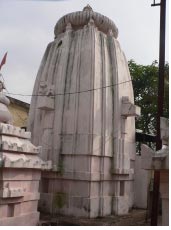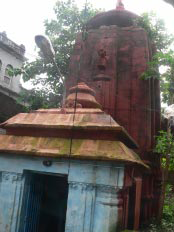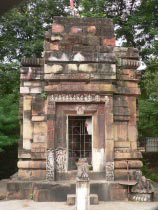
Aisanyesvara Siva Temple is a 13th-century Hindu temple dedicated to Shiva located in Bhubaneswar, the capital of Odisha, India. The temple is in the precinct of Municipal Corporation Hospital, Sriram Nagar, Old Town, Bhubaneswar. It is close to the western compound wall of Lingaraj Temple. This is a living temple and with a shrine facing east.

Jalesvara Siva Temple Precinct is a Hindu Temple dedicated to Lord Siva situated on the southern outskirt of the village Kalarahanga at a distance of 2.00 km from Patia and 6.00 km south of Chudangagada in the northern outskirt of Bhubaneswar. The presiding deity is a Siva-lingam within a circular yonipitha inside the sanctum, which is 1.15 meters below the chandrasila. The sanctum measures 2.00 square meters.

Lokanatha Siva Temple also Amunha Deula is an 11th-century AD temple in Bhubaneswar in the state of Odisha, India. It represents a proto type of Lingaraja in a miniature form. Lokanatha Siva temple is located in front of the Lingaraja temple in the south eastern corner across the road and adjacent to Lingaraja Temple Police Station in Old Town, Bhubaneswar. Until 1972 the temple was buried from all sides up to the bandhana portion, giving an impression as if the temple had no entrance. Hence people called it Amuha deula. In 1972 Debala Mitra conducted an excavation in front of the northern wall and exposed the entrance. The sanctum was empty. However, on the basis of the local traditions and the sculptural embellishment on the outer wall it was ascribed to Lord Siva. It is now known both as Lokanatha Siva and Amuha deula. People ascribe the temple to the Kesharis (Somavamsis). Except the entrance all other sides it is buried up to the bandhana.

Arjunesvara Siva Temple is a 12th Century A.D. temple in Bhubaneswar, in the state of Orissa, India. The temple is situated on the southern embankment of the Bindusagar tank at a distance of 70 metres and situated on the right side of the ratha road branching from the road leading from Lingaraja temple to Ramesvara temple. The temple is facing towards west.

The Bhringeswara Shiva temple is situated on the foothills of Dhauli and the left bank of the Daya River, in the southeastern outskirts of Bhubaneswar in the village Khatuapada. The temple is facing towards west and the presiding deity is a circular yoni pitha with a hole at the centre. The temple is made of light grey sandstone. The temple is renovated one from bottom to the top by employing the earlier materials. This temple is now under the protection of Odisha State Archaeology.

Champakeswara Shiva Temple is located Ambika Sahi in the Old Town area of Bhubaneswar in Odisha, India. It is 157 metres west of Parasuramesvara on the right side of the Kotitirthesvara lane leading to Bindu sagara. It is a laterite temple. Local people believe that the enshrined Siva lingam is patalaphuta and the precinct is the abode of nagas after whom the deity is named as Champakesvara. The local people also believe that the temple precinct which is a den for the snakes do not harm any body.

Chintamaniswar Shiva Temple is a Hindu temple dedicated to Lord Shiva in Bhubaneswar, the capital of Odisha, India. It is at the end of the Chintamaniswar road branching from Cuttack-Puri road near the Old Station Bazar. The temple faces west and the enshrined deity is a Siva lingam with a yonipitha.

Purvesvara Siva Temple is located in Kancha Sahi, in the Old Town of Bhubaneswar. It was built in 13th century AD. It is a living temple and now under the care of Purvesvara Temple Development Association.

Nilakantha Siva temple is located in the Kharakhia Baidyanatha temple precinct, Kharakhia Vaidyanath Sahi, Old Town, Bhubaneswar. One can approach to this site on the left side of the Vaidyanath road leading from Lingaraja temple to Kapilesvara. This is a living temple and is facing towards the west. The enshrining deity of this temple is a Siva lingam within a circular yoni pitha at the centre of the sanctum sanatorium. The sanctum is 0.77 metres below the chandrasila.

The Somesvara Siva temple is located in the Kharakhia Baidyanath temple precinct in Kharakhia Vaidyanath Sahi, Old Town, of Bhubaneswar. It is located approximately 300 metres south of Lingaraja temple. Visitors may approach the site on the left side of Baidyanath Road leading from Lingaraja temple to Kapilesvar. It is a living temple and faces towards the west. The enshrined deity of this temple is a Siva lingam within a circular yonipitha at the center of the sanctuary located 0.93 metres below the chandrasila. The temple is under the care and maintenance of Babulal Makaddam Badu Mohapatra, the chief priest of the temple, on whose private land the temple stands.

Isanesvara Siva Temple is a 13th-century ad temple in Bhubaneswar in the state of Orissa, India. The time period of its construction is estimated from its architectural features and it is suggests the temple to ganga period. Isanesvara Siva temple is situated in the Goasagaresvartemple precinct. It is located on the left side of Ratha road old Town, Bhubaneswar. It is located at a distance of 1 km west of Lingaraja Temple and 1 km south of Ananta Vasudev, 300 metres south west of Ramesvara temple and 200 metres north west of Baitala Deula. The temple is facing towards east. The presiding deity is only a circular yon pitha. The lingam is missing.

Gangesvara Siva Temple is situated within a precinct on the left side of the Ganges–Yamuna road Old Town, Bhubaneswar. It is located at a distance of 200 metres north-east of Lingaraj temple, 50 metres north of Lakhesvara temple across the road, 200 metres south of Subarnesvara and 100 metres east of Gourisankar temple. The temple is facing towards east. The presiding deity is a Siva lingam within a circular yonipitha. It is a living temple and maintained by the Ganga YamunaSangathana.

Ladu Baba Temple is a temple in Bhubaneswar, Odisha, India. It was built in the 13th century AD and was formerly known as Kainchhi Temple.

The Tirthesvara Siva temple is a Hindu template located in Bhubaneswar, the capital of Orissa, India.

Lakhesvara Siva temple Location: Lat 20° 14’ 33"N, Long 85° 50’ 17" E, Elev 60 ft. Approach- Lakhesvara Siva temple is located in the right side of the Ganges–Yamuna road, behind the Lingaraja market complex, Old town, Bhubaneswar. It is situated at a distance of 70 metres north east of Lingaraj temple and at a distance of 10 metres south of Gangesvara and Yamunesvara Siva temple across the road. The temple is facing towards the east. The enshrining deity is a Siva lingam within a circular yoni-pitha, which is 0.77 metres below the chandrasila.

Mangalesvara Siva Temple is a Hindu temple located in Bhubaneswar, Orissa, India. It is located at Lat- 20◦ 14’ 38" N., Long- 85◦ 50’ 38" E., and at an elevation of 45 ft.

The Talesvara Siva temple is a Hindu temple in Bhubaneswar, Odisha, India.

Subarnesvara Siva temple is situated on the left bank of Lingaraja west canal, which can be approached through Kotitirthesvara lane leading from Parasuramesvar temple to Bindu sagar. It stands opposite to Nagesvara across the Lingaraja west canal at a distance of 10.35 metres. The temple is facing towards east. The enshrined deity is a Siva lingam within a circular yoni pitha in the sanctum measuring 2.35 square metres, which is 1.20 metres below the chandrasila of the door.

Astasambhu Siva Temples is a collection of 8 Hindu temples dedicated to Lord Siva located in Bhubaneswar, the capital of Odisha, India.
Lakhesvara Siva temple is in Bhubaneswar in the Indian state of Orissa. The temple dates from the 13th century AD. The temple faces the east. The enshrining deity is a Siva lingam within a circular yoni-pitha, which is 0.77 m below the chandrasila. The local people are indifferent towards the legends of the temple. It is looked after by the Ganga-Yamuna Sangathana.












